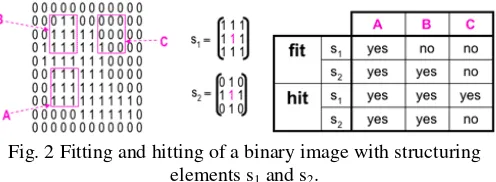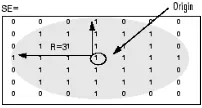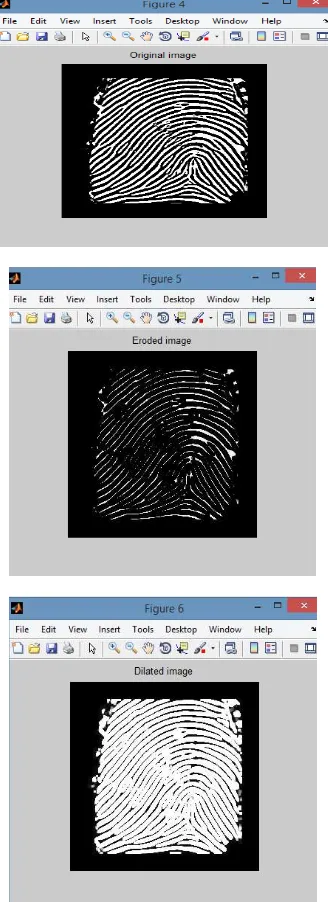ISSN: 2394-9333, www.ijtrd.com
Effective Morphological Image Processing Techniques and
Image Reconstruction
Abstract— Morphological image processing is a collection of
non-linear operations related to the shape or morphology of features in an image. Morphology is a broad set of image processing operations that process images based on shapes. Morphological operations apply a structuring element to an input image, creating an output image of the same size. In a morphological operation, the value of each pixel in the output image is based on a comparison of the corresponding pixel in the input image with its neighbors. By choosing the size and shape of the neighbourhood, you can construct a morphological operation that is sensitive to specific shapes in the input image. The most basic morphological operations are dilation and erosion. Dilation adds pixels to the boundaries of objects in an image, while erosion removes pixels on object boundaries. The number of pixels added or removed from the objects in an image depends on the size and shape of the structuring element used to process the image. In the morphological dilation and erosion operations, the state of any given pixel in the output image is determined by applying a rule to the corresponding pixel and its neighbors in the input image. The rule used to process the pixels defines the operation as a dilation or an erosion. This table lists the rules for both dilation and erosion.
Keywords—Image Processing; Morphology; Structuring
Element; Dilation; Erosion; Opening And Closing.
I. INTRODUCTION
Morphological operations rely only on the relative ordering of pixel values, not on their numerical values, and therefore are especially suited to the processing of binary images. Morphological operations can also be applied to greyscale images such that their light transfer functions are unknown and therefore their absolute pixel values are of no or minor interest. Morphological techniques [13] probe an image with a small shape or template called a structuring element. The structuring element is positioned at all possible locations in the image and it is compared with the corresponding neighbourhood of pixels. Some operations test whether the element "fits" within the neighbourhood, while others test whether it "hits" or intersects the neighbourhood, white and grey pixels have zero and non-zero values, respectively.
Fig.1 Probing of an image with a structuring element
A morphological operation on a binary image creates a new binary image in which the pixel has a non-zero value[8] only if the test is successful at that location in the input image. The
structuring element is a small binary image, i.e. a small matrix of pixels, each with a value of zero or one:
The matrix dimensions specify the size of the
structuring element.
The pattern of ones and zeros specifies the shape of the structuring element.
An origin of the structuring element is usually one of its pixels, although generally the origin can be outside the structuring element.
A common practice is to have odd dimensions of the structuring matrix and the origin defined as the centre of the matrix. Structuring elements play in morphological image processing the same role as convolution kernels [17] in linear image image if, at least for one of its pixels set to 1 the corresponding image pixel is also 1 [6].
Fig. 2 Fitting and hitting of a binary image with structuring elements s1 and s2.
Zero-valued pixels of the structuring element are ignored [12], i.e. indicate points where the corresponding image value is irrelevant. The fundamental morphological operations are dilation and erosion [16].
II. DILATION
ISSN: 2394-9333, www.ijtrd.com
National Conference on “Digital Transformation –Challenges and Outcomes” (ASAT in CS'17) organized by Department of
erosion [7], it adds a layer of pixels to both the inner and outer boundaries of regions.
Fig.3 Morphological Dilation of a Binary Image
Fig.4 Morphological Dilation of a Gray Scale Image
Morphological functions position the origin of the structuring element, its centre element, over the pixel of interest in the input image. For pixels at the edge of an image, parts of the pixels varies for dilation and erosion operations.
III. EROSION square structuring elements shrinks an image by stripping away a layer of pixels from both the inner and outer boundaries of regions. The holes and gaps between different regions become larger, and small details are eliminated. Larger structuring elements have a more pronounced effect [11], the result of erosion with a large structuring element being similar to the result obtained by iterated erosion using a smaller structuring element of the same shape. If s1 and s2 are a pair of structuring
is an image of the region boundaries.
Fig.5 Erosion of a gray scale image
Erosion and dilation can be done in 3D space, that is, with gray levels [15]. 3D structuring elements can be used, but the simplest and the best way is to use a flat structuring element B. 1D cross section of dilation and erosion of a grayscale image A
by a flat structuring element B [2]. In the figure, B has an anchor slightly to the right of the center as shown by the dark mark on
B.
Fig.6 Cross Section of Dilation and Erosion of AxB
IV. RESULTS AND DISCUSSION
A. Structuring Element
We have used MATLAB 2014a for our experiments on the morphological image processing. Strel function is used to create the morphological structuring element. SE = strel(shape, parameters) creates a structuring element, SE, of the type specified by shape. Depending on shape, strel can take additional parameters. The shapes can be diamond, disk, line, rectangle, square etc. SE = strel('diamond', R) creates a flat, diamond-shaped structuring element, where R specifies the distance from the structuring element origin to the points of the diamond. R must be a nonnegative integer scalar.
Fig. 7 a flat, diamond-shaped structuring element
B. Dilation
ISSN: 2394-9333, www.ijtrd.com
Fig.8 Original Fingerprint image after Erosion and Dilation
C. Erosion
IM2 = imerode(IM,SE) erodes the grayscale, binary, or packed binary image IM, returning the eroded image IM2. The argument SE is a structuring element object or array of structuring element objects returned by the strel function. If IM is logical and the structuring element is flat, imerode performs binary erosion; otherwise it performs grayscale erosion. If SE is an array of structuring element objects, imerode performs multiple erosions of the input image, using each structuring element in SE in succession.
D. Opening and Closing
Opening and closing are two important operators from mathematical morphology. They are both derived from the fundamental operations of erosion and dilation. Like those operators they are normally applied to binary images, although there are also graylevel versions. The basic effect of an opening is somewhat like erosion in that it tends to remove some of the foreground (bright) pixels from the edges of regions of foreground pixels [9]. However it is less destructive than erosion in general. As with other morphological operators, the exact operation is determined by a structuring element. The effect of the operator is to preserve foreground regions that have a similar shape to this structuring element, or that can
completely contain the structuring element, while eliminating all other regions of foreground pixels [14].
IM2 = imopen(IM,SE) performs morphological opening on the grayscale or binary image IM with the structuring element SE. The argument SE must be a single structuring element object, as opposed to an array of objects. The morphological open operation is an erosion followed by a dilation, using the same structuring element for both operations. IM2 = imclose(IM,SE) performs morphological closing on the grayscale or binary image IM, returning the closed image, IM2. The structuring element, SE, must be a single structuring element object, as opposed to an array of objects. The morphological close operation is a dilation followed by an erosion, using the same structuring element for both operations. An image will undergo a series of dilations and erosions using the same, or sometimes different structuring elements. There are three most common combinations of dilation and erosion: opening, closing and hit-or-miss transformation.
ISSN: 2394-9333, www.ijtrd.com
National Conference on “Digital Transformation –Challenges and Outcomes” (ASAT in CS'17) organized by Department of
E. Applications
Morphological smoothing is performed by opening followed by a closing, which results in removal or attenuate both bright and dark artifacts and noise. Dilation and erosion are used to
compute the morphological gradient of an image. It highlights sharp gray-level transitions in an image, which is obtained using symmetrical structuring elements tend to depend less on edge directionality. Top-hat transformation is done by cylindrical or parallelepiped structuring element function with a flat top, which helps in enhancing details in the presence of shading. The objective of textural segmentation is to find the boundary between different image regions based on their textural content. For textural segmentation we close the input image using successively larger structuring elements. Then, single opening is performed and finally a simple threshold that yields the boundary between the textural regions. Granulometry is a field that deals principally with determining the size distribution of particles in an image. Because the particles are lighter than the background, we can use a morphological approach to determine size distribution, which is useful to describe regions with a predominant particle-like character. Thus morphological image processing is very effective in removal of unnecessary details and reconstruction of images.
References
[1] C. Clienti, S. Beucher, and M. Bilodeau, “A system on chip
dedicated to pipeline neighborhood processing for mathematical morphology,” IEEE Conference in Signal Processing, 2008 16th European, pp. 1–5, 2008.
[2] C. Torres-Huitzil, “Fast hardware architecture for grey level image morphology with flat structuring elements ,” IET Image Processing, vol. 8, no. 2, pp. 112–121, 2013.
[3] G.V.Tcheslavski, “Morphological Image Processing:
Grayscale morphology”, ELEN 4304/5365 DIP, Spring 2010.
[4] H.Heijmans, “Morphological image operators”, Advances
in Electronics and Electron Physics.Academic Press, 1994.
[5] Haralick, S. Sternberg, and X. Zhuang, “Image analysis
using mathematical morphology”, IEEE Transactions on Pattern Analysis and Machine Intelligence, vol. 9, no. 4, pp. 532.550, July 1987.
[6] J. B ́artovsk`y, P. Dokl ́adal, E. Dokl ́adalov ́a, and V.
Georgiev, “Parallel implementation of sequential
morphological filters,” Journal of Real -Time Image
Processing, vol. 9, no. 2, pp. 315–327, 2014.
[7] J. Gil and R. Kimmel, “Efficient dilation, erosion, opening,
and closing algorithms”, IEEE Transactions on Pattern
Analysis and Machine Intelligence, vol. 24, no. 12, pp. 1606.1617, December 2002.
[8] J. Gil and R. Kimmel, “Efficient dilation, erosion, opening
and closing algorithms in Mathematical Morphology and its applications to Image and Signal Processing” V, J. Goutsias, L. Vincent, and D.Bloomberg, Eds. Palo-Alto, USA, June 2000, pp. 301.310, Kluwer Academic Publishers.
[9] L.Vincent, “Morphological area openings and closings for
greyscale images”, in Proc. Shape in Picture '92, NATO Workshop, Driebergen, The Netherlands, September 1992, Springer-Verlag.
[10] O. D ́eforges, N. Normand, and M. Babel, “Fast recursive grayscale morphology operators: from the algorithm to the
pipeline architecture,” Journal of Real-Time Image
Processing, vol. 8, no. 2, pp. 143–152, 2013.
[11] P. Dokl ́adal and E . Dokladalova, “Computationally
efficient, one-pass algorithm for morphological filters,”
Journal of Visual Communication and Image
Representation, vol. 22, no. 5, pp. 411–420, 2011.
[12] R. M. Gibson, A. Ahmadinia, S. G . McMeekin, N. C.
Strang, and G. Morison, “A reconfigurable real-time
ISSN: 2394-9333, www.ijtrd.com
Journal on Advances in Signal Processing, vol. 2013, no. 1,pp. 1–13, 2013.
[13] R.C.Gonzales, R.E.Woods, “Digital Image Processing”, 2nd Edition, Prentice Hall, 2002.
[14] Ryan P. Avery, Guohui Zhang and Yinhai Wang, “An
Investigation into Shadow Removal from Traffic Images”, University of Washington,2007.
[15] Serra.J, “Mathematical Morphology and Its Applications to Image Processing”, Kluwer Academic Publishers, Boston (1994)
[16] U.Scot.E, ”Computer Vision and Image Processing”,
Prentice Hall, NJ, 1998, ISBN 0-13-264599-8.
[17] Z.Fang, M.Yulei, Z.Junpeng, “Medical Image Processing
Based on Mathematical Morphology”, The2nd


